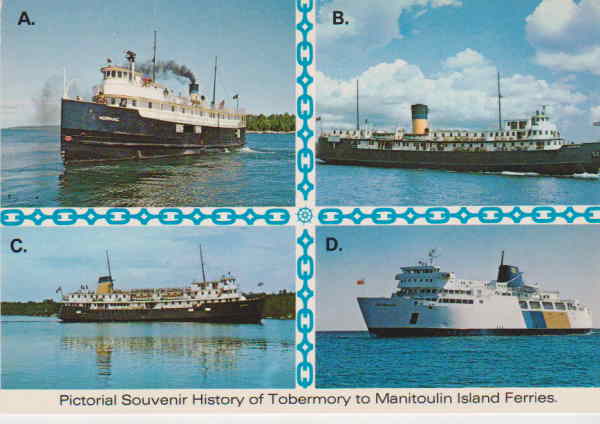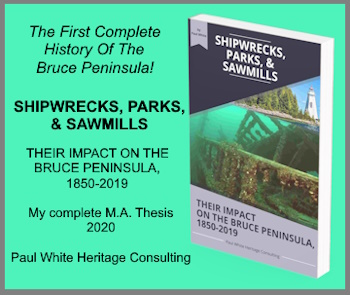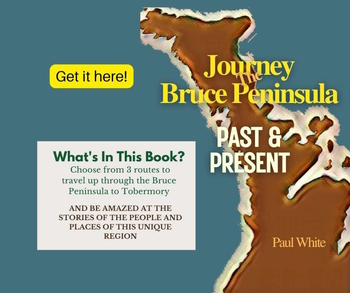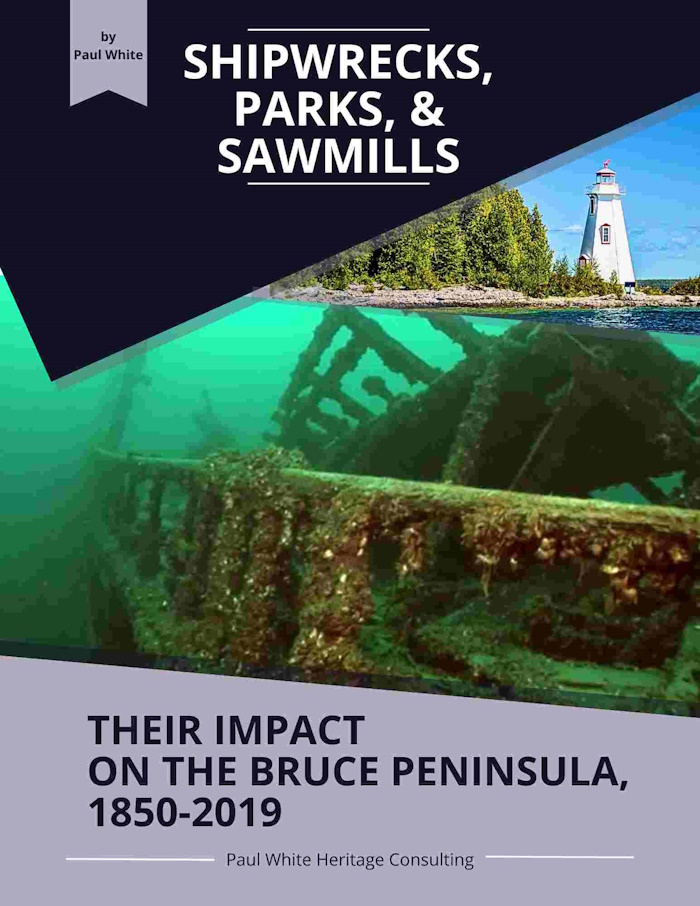Ferry Boat Service
Ferry boat service increased in activity after 1930 between Tobermory on the Bruce Peninsula and Manitoulin Island.
 Ferry Boats - The Four Most Recent to Service Manitoulin and Tobermory - A/ Normac, B/ Norisle, C/ Norgoma and D/ Chi Cheemaun - Paul White Historic Postcard Collection
Ferry Boats - The Four Most Recent to Service Manitoulin and Tobermory - A/ Normac, B/ Norisle, C/ Norgoma and D/ Chi Cheemaun - Paul White Historic Postcard CollectionThe ferry boat service between Owen Sound, the Bruce Peninsula and Manitoulin Island encouraged a growth in tourism in the area during the 1930s. However, while this situation may have proved to be a boon to one sector of the region’s economy, it also may have encouraged the end of another commercial enterprise in the area.
Advertisements in the 1930s enticed travelers to visit Manitoulin Island. The lure of the unspoiled natural beauty of the region was extolled in eloquent prose. The enticement to travel to the area was further heightened with descriptions of the easily accessible roads. The question of the quality of the roads was however questionable. The Bury road to Tobermory was given a gravel top in the late 1920s. But locals said that the road would “still make a fisherman seasick”.
In 1936 the two Owen Sound based companies involved in the ferry service, the Dominion Transportation Company and the Owen Sound Transportation Company, entered into a pooling agreement to provide more effective service. A year later, in 1937, the Dominion Transportation Company was purchased from Booth and Sons of Chicago. At first the company was called the Dominion and Owen Sound Transportation Company, but it soon shortened its title to simply the Owen Sound Transportation Company.
The Dominion vessels, the Caribou and the Manitou, went into service on the line with the Hibou and the Normac.
Unfortunately, the Hibou sunk at Owen Sound in the fall of 1936. In 1939 the Manitou was sold, leaving the Normac and Caribou to handle the ever-increasing traffic between the peninsula and Manitoulin Island.
The ferry boat service became known for its long waiting times for passage, as cars lined up for hours waiting for their turn on the small ships. The Caribou could only take 13 cars and the Normac 12. The two vessels would make six return trips a day, starting at 6:00 am and ending around 2:00 am the following morning. It was reported that during the weekends there were as many as 150 cars waiting to board. To accommodate the demand, the ships often ignored their schedules and tried to cram in extra trips, to try and ease the waiting times for often impatient travelers.
Many who traveled on the ferries during that era recall entering either Tobermory or South Baymouth in the evening and seeing the sky lit up by the fires of the campfires of stranded travelers. The two ports were small villages and prior to this influx of travelers there had been little need for commercial establishments to service the needs of the ferry boat passengers. Fortunately, entrepreneurs saw this need and both communities soon saw the development of commercial establishments to service this need.
Ferry Boat Service Improves with the Building of the Norisle
To improve the ferry service, the company built a new boat at the Collingwood shipyards in 1946. The 1,668 ton Norisle went into service in 1947. Her capacity was much larger than any of the previous vessels which had served the ferry line. The Norisle could carry 248 passengers, including a crew of 47, as well as 50 automobiles.
By promoting the ferry service and making Manitoulin Island and the Peninsula a destination point for travelers, the Owen Sound Transportation Company may have hurt another part of their enterprise.
As the popularity of travel to the region increased, more roads were built. Soon most of the outports in the region were accessible by road. Consequently, trucks could now pick up and drop off the produce which had once been carried by the company’s vessels which plied the waters around the peninsula and Manitoulin. In their efforts to open up the region to encourage the use of the ferry boats by tourists, the conditions had been created which may have destroyed the coastal shipping trade.
A version of this article first appeared in my Local History column in the Owen Sound Sun Times.
More Georgian Bay Sailing Stories
Lighthouses were vital to Georgian Bay and Great Lakes sailing traffic. They assisted mariners in making their sailing a safe venture.
Recreational Boating on Georgian Bay There is a long tradition of recreational boating on Georgian Bay. Reports indicate that regattas were being held at Owen Sound as early as 1852.
Great Lakes Recreational Boating Great Lakes recreational boating has been a popular pastime in the summertime in the Georgian Bay region for many years.
Yachts on Georgian Bay A history of yachts on Georgian Bay.
Georgian Bay Ferry Boat Service between Tobermory and Manitoulin Island has a history that is more than a century old. Today, the Chi-Cheemaun continues that tradition.
Ferry boat service after 1930 increased in activity between Tobermory at tip of the Bruce Peninsula and Manitoulin Island
1867 Election Meant Sailing to the Soo. There was only one polling station in the Georgian Bay region in the first election after Canadian Confederation and that was in Sault Ste. Marie!
A Flowerpot Island boat trip takes you to one of the many Georgian Bay islands dot the landscape of the waters around Tobermory at the tip of the Bruce Peninsula. One island features not only unique landforms and vegetation, but also a mysterious indigenous Romeo and Juliet tale of romance.
Chicora the first stage of an 1871 Great Lakes tour aboard a cruise ship on Georgian Bay.
Chicora the final stage of an 1871 cruise a foggy voyage on the Great Lakes.
Historic Vacations: King's Royal Park Historic Vacations: King's Royal Park, opulent adventures for the wealthy of the day. It was the late 19th century and tourism was beginning to bloom.
Sailing the Lake Huron Shoreline is a step back in history and a delightfully scenic trip. But beware of the big waves that can arise anytime!
Sailing Lake Huron Shoreline Part 2 takes us through the most treacherous part of our voyage and also a most interesting part as we visit some unique islands.
Georgian Bay Sailing Georgian Bay Sailing history is a rich tapestry of tales of heroism, tragedy, and exploration. Sailing vessels traversing the rugged waters of Georgian Bay predate the arrival of European explorers and settlers.
Boating for Recreation on Georgian Bay and beyond had an early start once settlement began in the region. As early as the 1850s pleasure crafts were popular.





